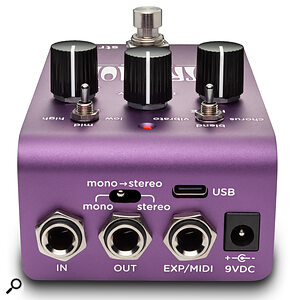The Ultraviolet is the third pedal to join the ranks of Strymon’s new compact line of ARM‑powered processors, all of which include Class‑A JFET preamps and which are equally happy accepting guitar or keyboard signals. TRS jacks are used for the audio connections, allowing for mono or stereo operation, and the pedal can be set to true or buffered bypass.
The original Shin‑Ei Uni‑Vibe used an LFO to modulate a light source, around which were located four photocells: its operation was somewhat like that of a phaser, but differences between the four stages gave the Uni‑Vibe a unique pulsing sound. Artists including David Gilmour, Jimi Hendrix and Robin Trower made great use of the original, and there seems to be a resurgence in popularity with every generation, so it comes as no surprise that there are several emulations and ‘re‑imaginings’ now on the market. Strymon have a lot of experience in creating modulation effects, of course, including the notoriously difficult‑to‑model rotary speaker, and now they’ve turned their attention to a single‑function pedal dedicated specifically to the Uni‑Vibe sound.
 Strymon Ultraviolet's connectivity options.
Strymon Ultraviolet's connectivity options.
The USA‑built Ultraviolet is housed in a purple metal case with all the connectors on the top edge of the pedal. A 9V clean supply of 250mA minimum is required (the PSU is not included). As with the other pedals in the range, all three permutations of mono/stereo in/out routing are available via a rear‑panel switch, there’s a USB‑C port for handling firmware updates or MIDI, and there’s an Ext/MIDI jack, which can be set to one of five modes: Expression Pedal, Favourite, Tap Tempo, Infinite or MIDI. Stereo operation requires a TRS adaptor to split the feeds in and out of the pedal. Up to 300 presets can be stored and recalled using MIDI, though there’s no front‑panel preset feature.
The control set is a little different from the other two pedals we’ve seen so far in this series, insomuch as there are only three rotary controls and a pair of three‑way toggle switches on the top panel. The three knobs set Speed, Intensity and Volume, while the left‑most switch selects between Chorus, Blend and Vibrato. Chorus uses an even mix of the wet and dry signals, while Vibrato uses only the wet signal. Blend is a halfway house between the two.
The other switch selects Low, Mid or High Bias and essentially sets the mid point of the LFO modulation. Low produces more pronounced low‑frequency modulation while Mid and High move the effect further up the audio spectrum. I’ve often found the Uni‑Vibe effect to sound a little ‘lumpy’ in comparison with a regular phaser and that sense of asymmetry is replicated very accurately by the Low Bias mode. For a less lumpy, generally brighter‑sounding result, the other two Bias positions offer very usable alternatives.
The switchable Bias and Blend options genuinely extend its usefulness.
Strymon’s pedals always attract praise for their sound quality and the accuracy of their emulations, and the Ultraviolet is going to be no exception. It is perfectly capable of delivering an authentic Uni‑Vibe sound that, at higher modulation rates, has an almost rotary speaker quality to it. However, the switchable Bias and Blend options genuinely extend its usefulness, and my personal preference when recreating those languorous slow sweeps (in Chorus mode) is to use the High Bias setting in combination with the Intensity control just past half way. Vibrato mode produces an organic‑sounding pitch modulation while Blend is useful if you want a more subtle version of the chorus effect. Having those switchable options makes it easy to find your own Goldilocks setting — not too lumpy, not too smooth, but just right! I have a feeling that this pedal is going to do very well amongst those who really appreciate the Uni‑Vibe sound.


